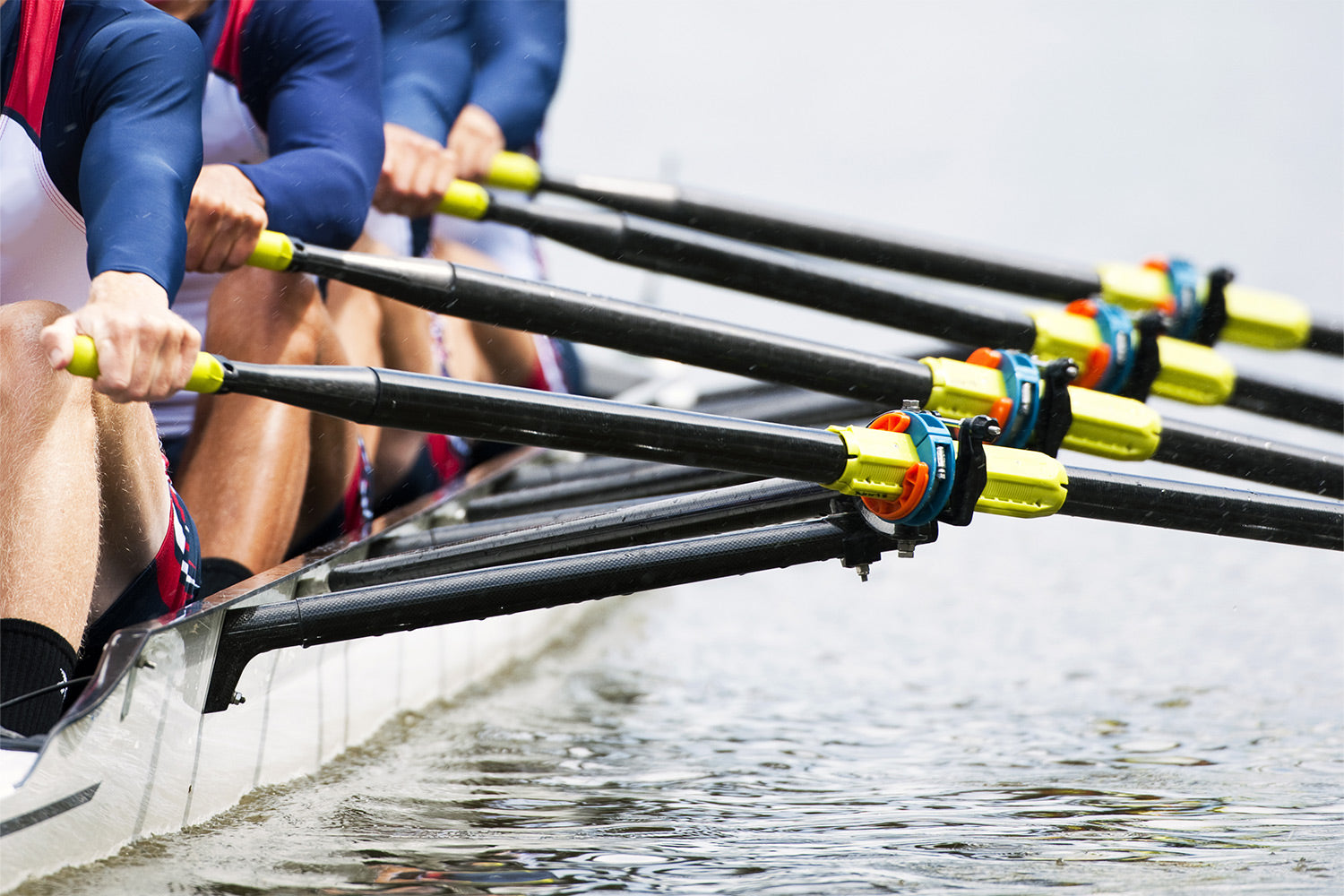Whether you’re a fitness veteran or first-time gym-goer, you’ve probably wondered: Is there a perfect workout? Is there one workout I can do that will fulfill all of my fitness needs? At EnergyFit, we’re excited to tell you that there just might be.
Rowing has long been touted as a “perfect” exercise as it provides a high-intensity, full-body workout. What does full-body mean? When it comes to rowing, it means that it works 85 percent of the body’s musculature.
With rowing being similar to swimming or cycling, it is considered a low impact workout. This means it is easy on the joints, making it a perfect workout for older individuals––especially considering it can be done at any intensity.
Have we convinced you that rowing is the perfect workout? If you want to give it a shot, check out the following guide on rowing.
Getting To Know the Machine
While there are a variety of rowing machines out there, there are two primary components that define a rowing machine. First, there is a seat that sits atop a rail. Second, there is a handle that you pull. Rowing machines can come in several varieties, but each will have these basic functions which comprise the rowing motion.
There are also two main types of rowing machines:
Air Rower
The most common is an air or flywheel rowing machine. There is a fan at the end of the machine in this variety that spins when you pull on the handle. Resistance is created by the air that pushes against the fan blades. Generally, you can set the resistance on a scale from 1-10, 10 being the highest resistance. Competitive rowers commonly set the resistance to four or five, as this most accurately mimics water resistance.
Air rowers create the most consistent and reliable strokes. Because of this, it is the machine of choice for competitive rowers and indoor rowing competitions.
Water Rower
The second most common variety is the WaterRower. Instead of using air as resistance, these machines use a small water tank to accurately mimic rowing on a boat. Water rowers also produce a much quieter sound that some find to be quite soothing. This makes it a good choice for homes; however, they are heavier and far less transportable than air rowers.
Ski-Row Air by EnergyFit
The Ski-Row Air and Ski-Row Air + PWR machines by EnergyFit are in a class of their own. While they provide the functionality of an air rowing machine, they combine the benefits of a ski machine. As a result, you get a full-body workout that targets the upper body much more effectively than rowing on its own.
These machines are fully collapsible and highly transportable, making them convenient and aesthetic for home gyms.
Perfecting the Stroke
The most important aspect of rowing is the stroke, as this is where most people mess up. Three motions comprise a rowing stroke. Keep in mind; these motions are to be completed sequentially, not at the same time.
The Catch
You begin seated with the seat all the way forward; your knees bent towards your chest. Your hands will be gripping the handle with your arms fully extended. Here, you are working your:
- Upper back
- Deltoids
- Glutes
- Quadriceps
- Hamstrings
- Calves
The Drive
With your seat all the way forward, knees bent to your chest, and arms fully extended while gripping the handle, you will extend your legs outward. As you fully extend your legs, you will pull your arms to your chest, creating a 90-degree angle (not all the way). This stroke works:
- Upper Back
- Triceps
- Pectorals
- Lats
- Abs
- Obliques
- Glutes
- Hamstrings
- Quads
- Calves
The Finish
Once your legs are fully extended, you will pull your arms to your abdominal region, past the 90-degree mark. This targets:
- Deltoids
- Triceps
- Biceps
- Pectorals
- Lats
- Abs
- Obliques
- Hamstrings
- Quadriceps
Rookie Mistakes To Avoid
Due to its simplicity, rowing is a fairly easy exercise to master; however, there are a few easy mistakes when you’re first starting out. These mistakes can have a negative impact on your form, and therefore your results.
- DO NOT fasten the footplate straps as tight as possible. While you want your feet to be secure, you do not want them to be completely locked in. When the straps completely constrict the foot, the result is less core activation.
- DO NOT set the machine to its highest resistance (at least at first). Beginners should start at a low resistance setting until they master the form. Then, if you want to focus on upper-body resistance training, you can crank it up to 11.
- DO NOT go as fast as possible. In fact, speed actually won’t have a great effect on the calories you burn. There’s a better chance it’ll mess up your form. Go at a steady, uniform pace to maximize your results.
- DO NOT do all of the strokes at once. Beginners should do each stroke in an isolated, sequential fashion. This will ensure you’re not rowing with only your arms or legs. The more you do it, the more fluid it will become.
- DO NOT lean too far back or forward—picture a clock. At the finish, you should be at 1 o’clock. On the catch, you should be at 11 o’clock. If you’re tempted to lean further back or forward, your resistance may be set too high.
- ALWAYS have fun. Rowing is a truly special exercise, and you should have fun doing it!
Producing Results
No matter what your fitness goal is, there’s a good chance that rowing regularly can help you get there.
One of the primary benefits of rowing is the cardio it provides via high-intensity interval training (HIIT). Just one hour of rowing will burn roughly 520 calories. Furthermore, the benefits of regular cardio training extend to improved mood, sleep, cognitive function, sexual function, digestion, and so much more.
Is rowing the best calorie-burning exercise out there? It actually isn’t. In fact, among workout machines, treadmills and stationary bikes will burn calories more efficiently than rowing machines. That being said, rowing machines provide a unique benefit that treadmills, stationary bikes, and other cardio machines do not: Resistance training.
Rowing builds lean muscle throughout the body. If you’ve ever seen a competitive rower, they are long and lean with an incredible definition in their arms, legs, and abdominal areas. This physique is achieved due to dozens of muscles that rowing engages with each stroke.
On top of a toned, athletic physique, building lean muscle will actually help boost your metabolism. This means that you will be burning more calories while at rest. Therefore, rowing might be the best way to achieve that if you want to burn as many calories as possible. Not only does it efficiently burn calories, but it also helps you achieve a body composition that will improve your metabolism.
Understanding the Metrics
Like treadmills or stationary bikes, most rowing machines have screens that provide the analytics of your workout. While there are basic metrics, such as calories burned, there are some rowing-specific numbers that you may not understand.
One such number is your stroke rate. In rowing terms, this is essentially your speed, measuring how many strokes you complete each minute. A normal stroke rate generally falls between 18-40 strokes per minute (SPM).
Your goal with SPM, though, shouldn’t be to raise it. Instead, it should be to reach a consistent rate throughout your workout. For example, an expert rower may never fall outside 25-30 SPM throughout a 45-minute workout. This means that their bodies are not only supremely conditioned but have also perfected the rowing stroke.
Another metric to understand is your 500-meter pace. Also referred to as your split time, your 500-meter pace indicates how long it would take you to row a boat 500 meters. This is measured by force––the harder you row, the lower your 500-meter pace. Similar to your SPM, a good 500-meter pace is a consistent one.
The more you row, the more your metrics will improve. Rather than force it, just focus on good form. No matter what pace you go at, you will achieve an excellent workout.
How Long Should You Row For?
Everyone has different bodies with different needs, so there’s no universal answer to this question. Like any exercise, listen to your body. Pain, nausea, and lightheadedness are all adequate signals that you should stop.
To maintain your health, the Department of Health and Human Services (DHHS) recommends that you get a minimum of 150 minutes of moderate-intensity cardio exercise or 75 minutes of vigorous-intensity cardio exercise per week. What’s the difference between moderate and vigorous-intensity exercise? If you can hold a conversation during the workout, it’s moderate. If not, it’s vigorous.
If your goal is to lose weight, you essentially need to double those figures. Keep in mind that exercise alone won’t help you reach your goals. Rather, diet and exercise together are what you need. The name of the game when it comes to losing weight is being in a calorie deficit.
Rowing for athletic purposes will usually require longer, more intense sessions. Furthermore, seasoned athletes may find benefit in conducting rowing drills.
Summing It Up
Rowing is one of the best workouts out there. With its combination of HIIT and resistance training, it is often considered a “perfect” workout. Not only does it work over 80 percent of the body’s musculature, building lean muscle, but it also provides high-quality cardio.
While rowing isn’t complicated, your success will completely rely on mastering the stroke. Once you have your form down, you will reach a point of consistency and, eventually, peak physical fitness.
Remember, keep your form tight, footplates lose, and numbers close together. As always, EnergyFit is here to help.
Sources
3 Rowing Machine Workouts for Cardio and Strength | Daily Burn
2015-2020 Dietary Guidelines | Health.gov
What Muscles Does a Rowing Machine Work? | AllRowers




Leave a comment
All comments are moderated before being published.
This site is protected by hCaptcha and the hCaptcha Privacy Policy and Terms of Service apply.